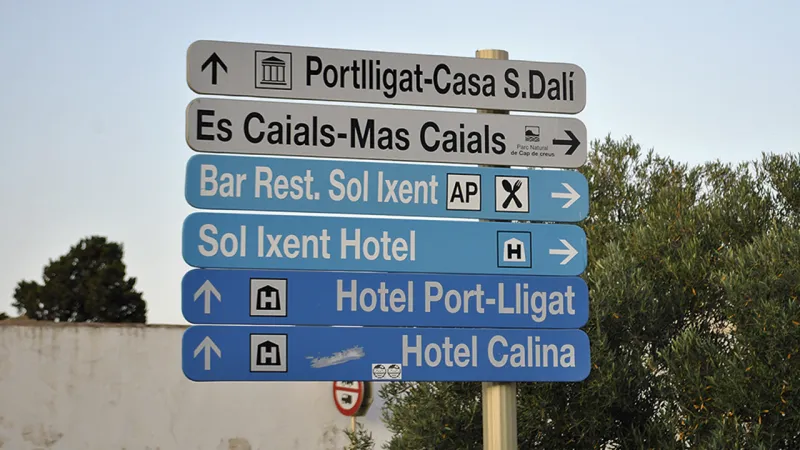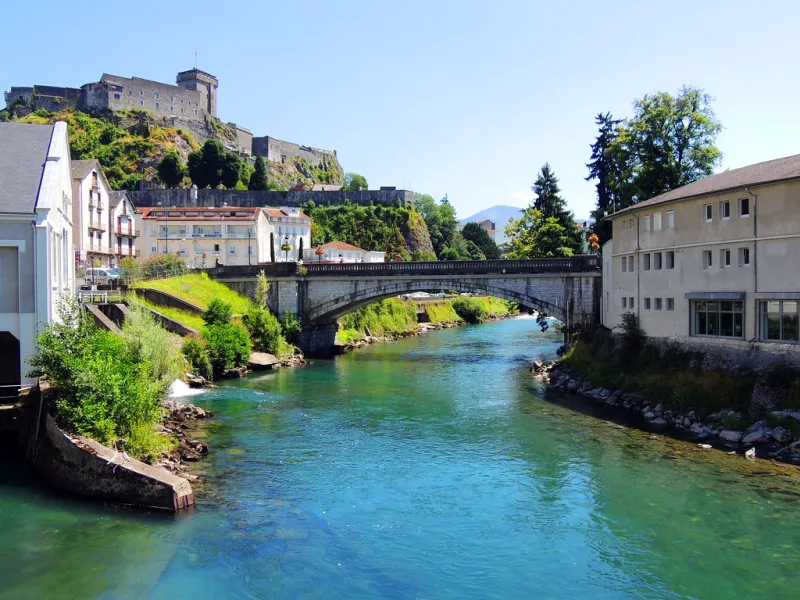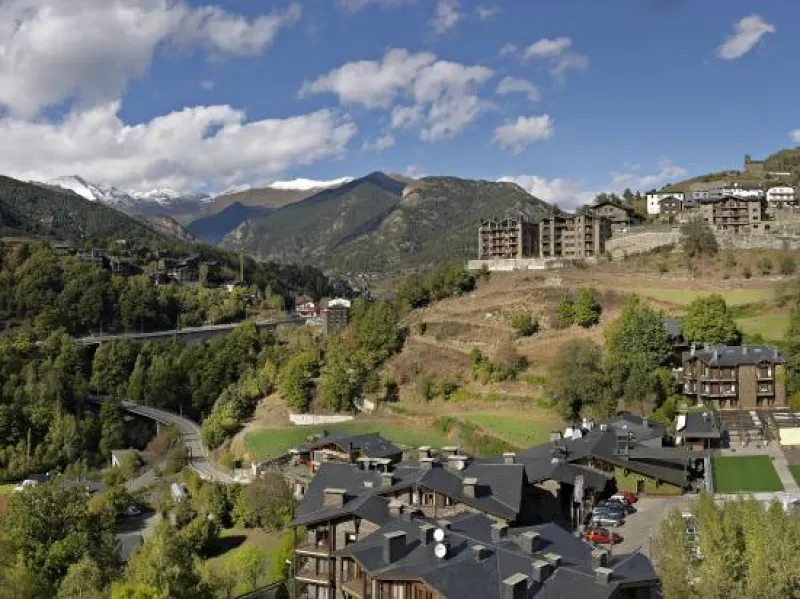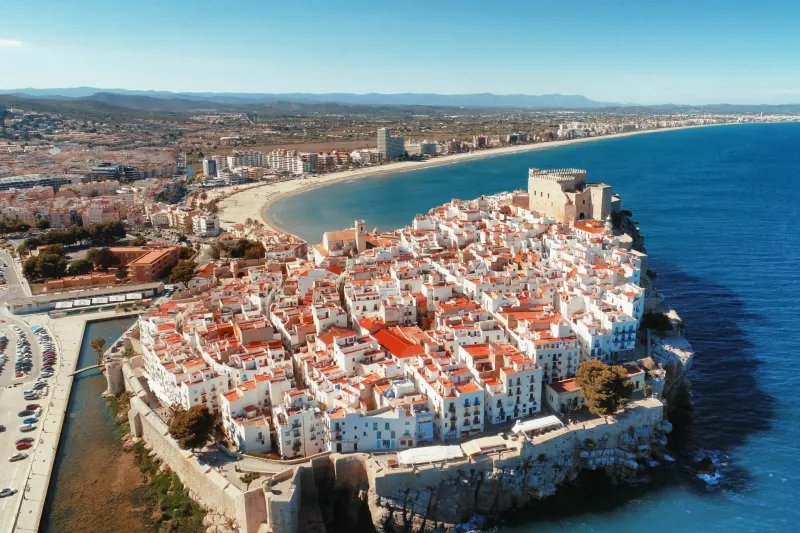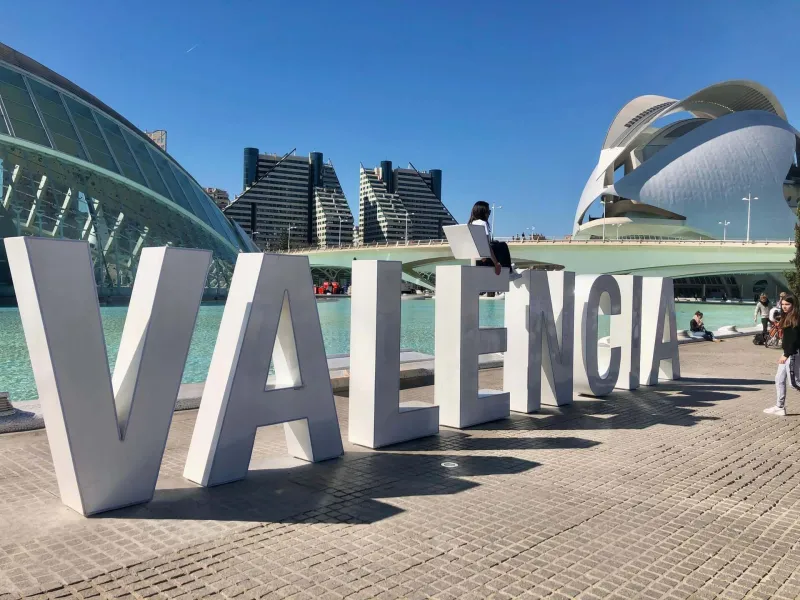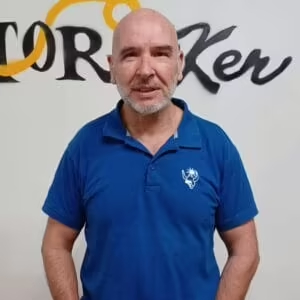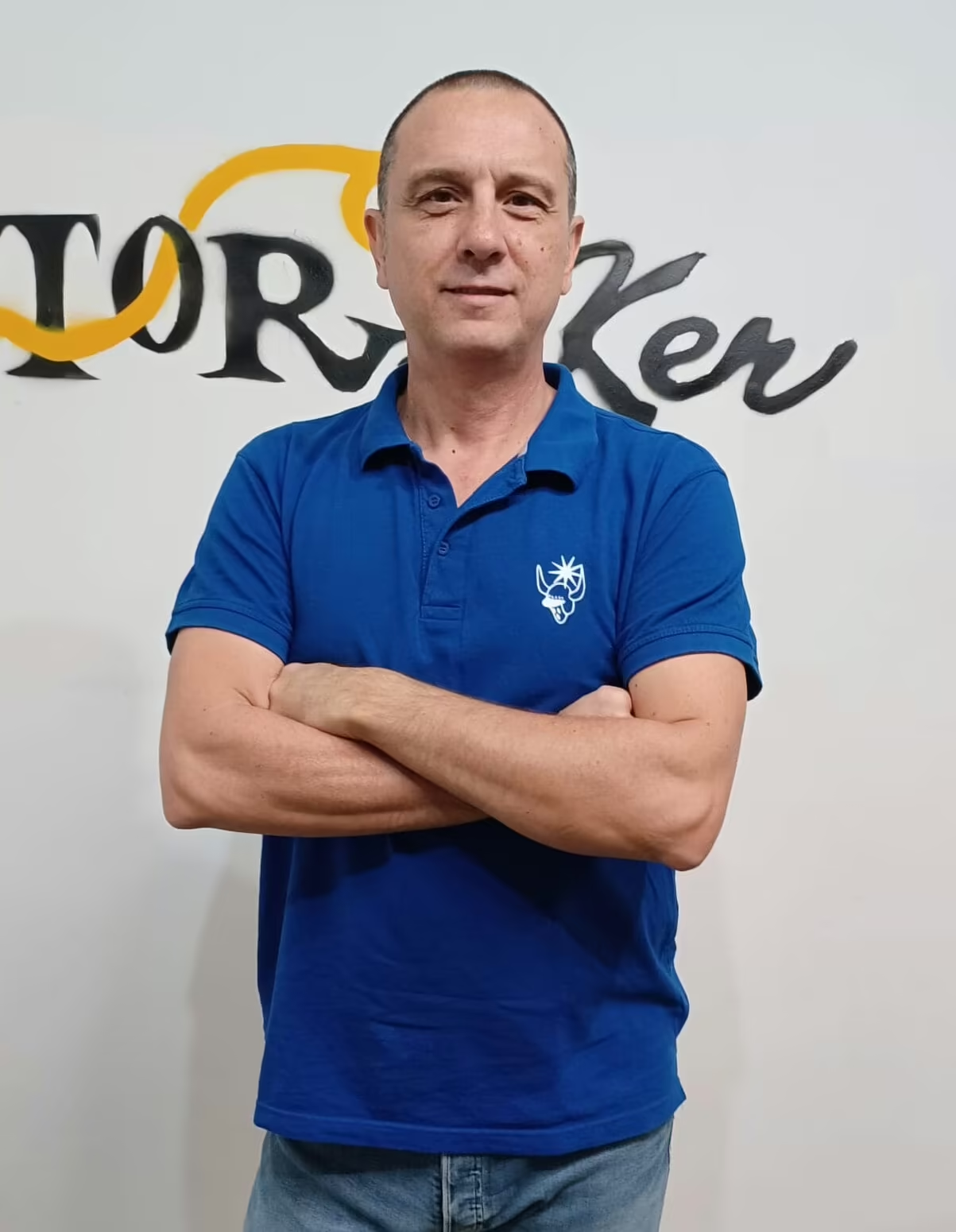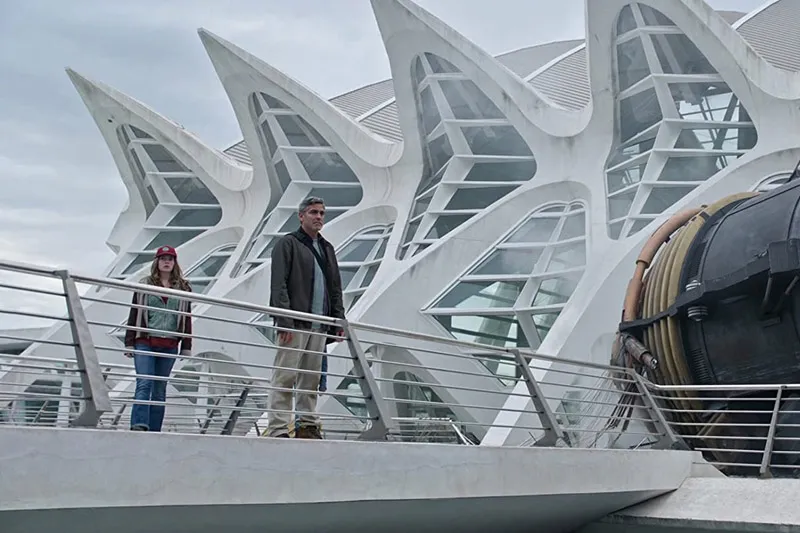
As with all organised motorbike tours, the first day is all about gathering everyone together at the starting point: Valencia.
Plan your trip so that you arrive in the Capital of the Turia around midday. If you’re coming by plane, train, bus or hire car, simply let us know your arrival station and time, and we’ll be there to pick you up and take you to the hotel where we’ll spend our first night.
If you’re arriving on your own motorbike, we’ll give you the hotel address and be waiting to welcome you at reception.
Once everyone has arrived, we’ll head over to the Toro Biker offices in Paterna to hand out jackets, helmets and gloves, and to hold the safety briefing where we’ll explain how the routes will work.
After the safety meeting and once everyone is kitted out, we’ll go and collect the hire bikes. If you’ve brought your own, come along anyway — it’s a great moment and you’re bound to enjoy it, even if it’s just watching the bikes... time really flies by!
Now that we’re all geared up, we’ll head out for a ride to see some of Valencia’s most iconic sights, starting with the Serrano Towers — one of the two remaining ancient gates into the city, which were preserved largely because from 1586 until the late 19th century they served as a prison for nobles and knights. This use justified their conservation when the rest of the city walls were demolished. And as a curious fact: during the Spanish Civil War, these towers were used to shelter artworks from the Prado Museum, protecting the paintings with concrete, layers of rice and sandbags. From prison to art gallery — quite a monument to versatility, don’t you think?
Having visited one of the city’s most historic landmarks, we’ll fast forward in time and go take some photos at the City of Arts and Sciences. Unless it’s changed dramatically, I’d say the building itself is worth more than what’s inside. Simply admiring the architecture — where you have to give Santiago Calatrava almost epic credit — is an extraordinary visual pleasure in itself. You’ve probably seen plenty of photos (and if you haven’t, I recommend you do). You might even recognise it from films like Tomorrowland with George Clooney, or from TV series such as Doctor Who (Series 10, Episode 2 “Smile”, broadcast in 2017), where several scenes were shot at the CACS, including an iconic moment with the police box.
If time allows, we’ll make it to the equally iconic Malvarrosa Beach, the beating heart of leisure in the city and a proud showcase of our Mediterranean spirit.
While we’re here, it only makes sense to have dinner in the area, given the huge and varied choice of restaurants. But I’ll let you in on a secret: I have a personal favourite among all these fantastic places, and if I can get a booking — which isn’t easy — that’s where we’ll eat. The cuisine is innovative, and the setting is truly something special, with the restaurant nestled among a couple of century-old ficus trees that by night steal the show with their sheer size and beauty. In short, a delight for all the senses.
After dinner, we’ll head back to the hotel to rest — tomorrow we start the route!
Good night, and welcome!
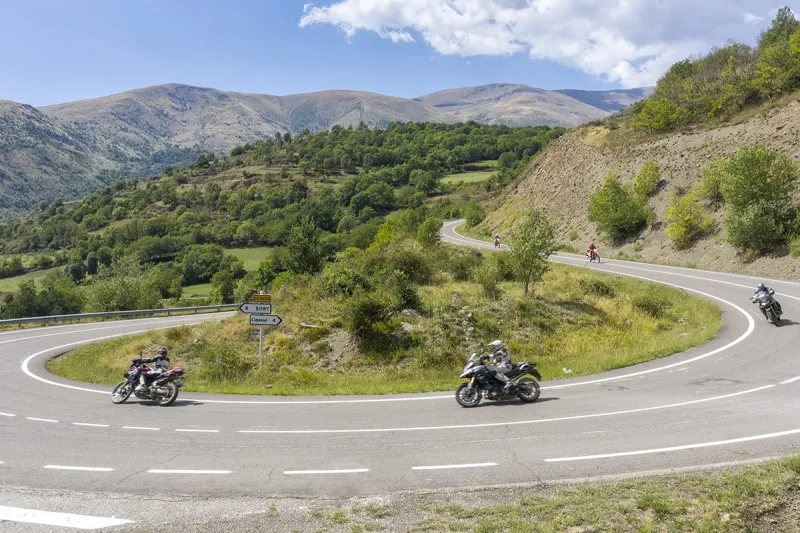
After breakfast and loading up the bikes, hand your travel bags to our Toro Biker team member so they can be safely stored at our offices.
Remember to pack only what you’ll need for the ride, as your luggage will be waiting for you at the end of the route when we return to Valencia.
Today’s route will take us to Cambrils. Sure, we could easily stick to the coastal road — but where’s the biker thrill in that? Honestly, in my view, those roads are nothing but boring stretches full of traffic, lorries, more lorries, and little else to see apart from the sea on your right. Definitely not our style — we’re heading inland!
We’ll start off by taking the exit towards Ademuz straight from our hotel, which we’ve chosen precisely for its perfect location. You roll right out of the hotel directly onto the route, without having to deal with the hassle of city traffic. So from the hotel, we’ll hit a three-lane motorway where you’ll get your first proper taste of the open road on your bike.
Gradually, the ride will pick up in terms of riding level, but in a way that allows you to discover all the wonderful things your travel companion has to offer. Naturally, the guide will control the pace, adjusting the ride to how you’re settling into the bike and the line of each curve, setting the tempo to keep the group as safe as possible. This will be a constant throughout the whole trip.
I can assure you we’re going to have great fun riding along the route I’ve planned, and of course, we’ll be treated to some truly spectacular landscapes. Honestly, sometimes it hardly feels like we’re just 60 or 70 kilometres from Valencia — it’s almost magical.
We’ll stop for lunch along the way, enjoying the local delights of the villages in inland Region of Valencia, before continuing on and riding through gems like the Cardó-El Boix mountain ranges. This stunning pre-Pyrenean massif is located in the Terres de l’Ebre area (Tarragona, Catalonia), around the Baix Ebre region.
It stands out as a strategic point for the migration of birds of prey such as short-toed snake eagles, black kites, peregrine falcons, Bonelli’s eagles, or the cuabarrada (I didn’t know it either, looked it up online, and it’s gorgeous) that soar over the massif, keeping us company along the route.
It’s quite a natural spectacle, but please make sure to enjoy it without taking your eyes off the road — the local four-legged wildlife likes to wander about here, and it’s not unusual for them to stop right in the middle of the road to say hello… or give you a bit of a fright, depending on the moment. So yes, please take extra care in these situations.
We’re planning to arrive in Cambrils by mid-afternoon, with plenty of time to freshen up and enjoy its nine kilometres of golden sandy coastline. Don’t worry — we won’t be walking all of them, I promise.
Do you think it’s a coincidence we’ve chosen to stop in what’s called the “Gastronomic Capital of the Costa Dorada”? If so, you’ve still got a lot to learn about how we travel at Toro Biker.
Cambrils is famous for its seafood cuisine and boasts more than 150 restaurants (some of which even have Michelin stars). So if we want to really treat ourselves to a culinary feast, this is undoubtedly the place. The gastronomy that’s earned it so much fame is based on fresh local products and traditional recipes like fideuà or suquet de peix.
Personally, I’d go for the suquet for dinner — but hey, everyone’s free to decide what they want to tuck into!
After dinner, we’ll enjoy a gentle stroll back to the hotel, which I’ve carefully selected to strike the perfect balance between comfort and price. Then off to sleep, lulled by the sound of the sea.
Good night!
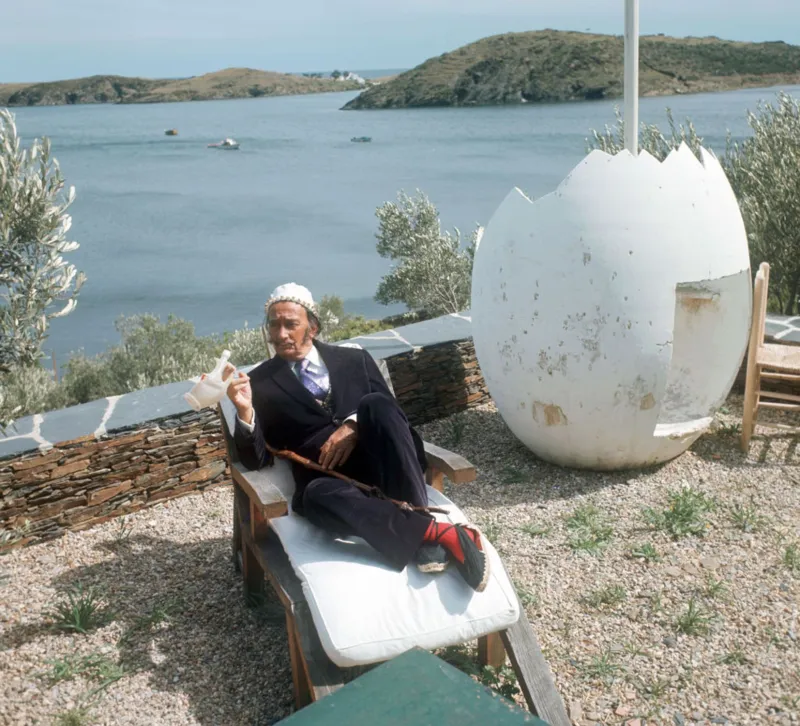
The alarm goes off, we get up, freshen up and head for breakfast. Afterwards, we jump back on the bikes and set course for Roses, the northernmost point of the Mediterranean where we’ll spend the night before turning west towards the Pyrenees.
Once again, we’re skipping the route that hugs the Mediterranean coastline — it’s simply a string of villages with little to offer in terms of real riding.
Instead, we’re heading inland to enjoy a road that, although it does have fairly heavy traffic (as it’s one of the main routes connecting southern Spain with Andorra), still gives us a wonderful mix of pleasant national roads and stretches along secondary roads that cut through ranges like the Alta Garrotxa. Its name itself gives us a clue as to what to expect: “Garrotxa” means “rough land, difficult to pass through”, and you’ll see why, with its deep valleys flanked by spectacular high limestone walls. Get ready for a true feast for the eyes.
A stop is a must to sample the local delights, which include one of my personal favourites: snails cooked in all sorts of ways. I confess — I love them all. But if you’re not a fan of this little gastropod turned local delicacy, fear not; you’ll have at your disposal a whole mountain and rural culinary tradition, with hearty dishes perfectly suited to the colder climate here. Typical are the “cocas de recapte” (a kind of flat bread dough, like a rustic pizza, topped with local produce, usually roasted vegetables and cured meats), artisanal sausages (longaniza, bull, secallona) and in autumn, the cuisine revolves around mushroom picking (rovellons, llenegues, ceps), which form the base of stews and rice dishes. One thing’s for sure — you won’t be going hungry.
After lunch, we’ll head straight to Portlligat to enjoy what I’ll call an “intangible treasure”: the light of this particular spot on the Mediterranean.
We’ll visit Dalí’s House Museum, and if you’ve got your senses even slightly switched on, you’ll quickly realise that this genius of surrealism left nothing to chance.
The location of the house facing the sea, quite apart from all the works of art it holds, is a marvel in itself. At sunset, when the Mediterranean swallows the sun, the light transforms the place into a fairytale scene. Yes, something as simple as sunlight — which we see every day, so familiar and apparently trivial — becomes pure magic here.
If you’ve never witnessed it, it’s definitely something for your “bucket list: spend a weekend in Portlligat”. If you like, I can even recommend the aparthotel I always stay at whenever I go there with my partner or family.
For dinner, we’ll backtrack to Roses, check in at our carefully chosen hotel, and head off in search of a seafront restaurant to let ourselves be won over once again by the culinary delights they’ll serve us. A sure bet: fresh fish baked in the oven.
After dinner, back to the hotel to sleep, rocked once more by the murmur of the sea. See you tomorrow!
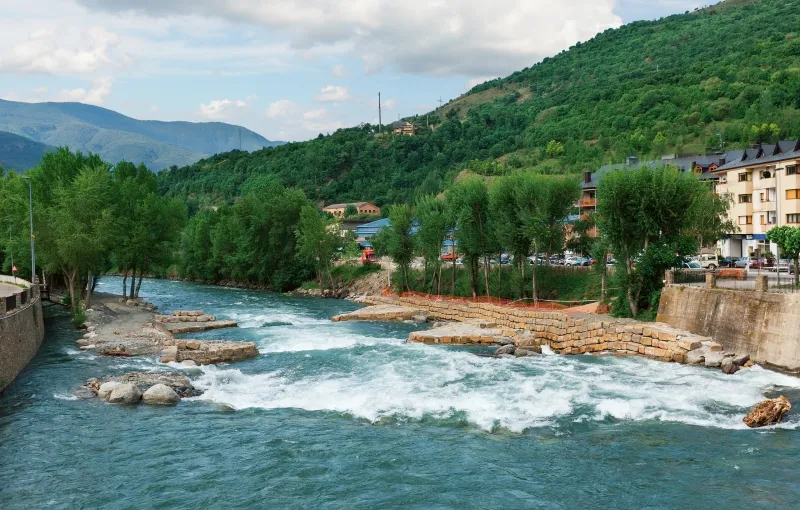
Good morning!
Today we’re calling this stage “From Range to Range”. Sounds good, right?
We leave the Mediterranean behind and point our wheels towards the Cantabrian coast, passing once again by the Alto Garrotxa, which we skirt to reach the Sierras of Milany-Santa Magdalena and Puigsacalm-Bellmunt. Just the names alone are impressive, aren’t they? And we’re only getting started. We’ll keep carving through twisties and enjoying ourselves as we dive into the heart of the Spanish Pyrenees via the Sierra de Catllarás, which pretty much links straight into the Cadí-Moixeró Natural Park, rolling on into the Sierra de Ensija and Els Rasos de Peguera. Alright, I’ll catch my breath here, because I promise you we’ll remember this day as one of the most thrilling for riding.
Once again, I want to remind you that this chain of passes, mountains, landscapes and raw nature is full of birds and four-legged mammals who like to pop by and say hello. Please, take it easy. I’ve even seen cows just standing in the middle of the road—need I say more?
This is one of those stretches where you’ll probably stop a couple of times to let the animals cross, so don’t stash your phone too far away—there’ll be plenty of opportunities to snap some truly stunning shots.
All this riding and soaking in nature will take us to lunch somewhere along the route, where we’ll be treated to artisan cheeses, cured meats like xolís (a local salami from the Pallars region), hearty stews like olla aranesa, and desserts such as coca cakes or local cow or goat milk yoghurts. Don’t know about you, but just describing these delicacies gets my mouth watering!
Speaking of Sort, it really is the heart of the Pyrenees, with towering mountains encircling a village shaped by the Noguera Pallaresa river, the region’s rafting hotspot. And of course, you can’t talk about Sort without mentioning La Bruixa d’Or, the famous lottery shop where, year after year, thousands flocked from all over Spain to try their luck with a Christmas ticket.
It used to be quite a sight seeing the queues form outside. Nowadays, with online sales, things have calmed down a bit. Still, if you’re into games of chance, and even though you could just buy it online, since we’re here, why not pop in—if the queue’s not too long—and pick up a ticket in person? It’s got that extra little charm.
Beyond the lottery, Sort (which literally means “Luck”, hence its fame among lottery lovers) is also a main gateway into Andorra from the south, especially for those of us coming from Valencia.
There’s also a lesser-known route starting from Sort that, via bumpy roads, dirt tracks, a few river crossings and a couple of climbs, pops you out at the top of Pal ski resort via the Coll de Cabús. I’ve done it several times on a Honda Varadero XL1000V with 90/10 tyres, no problem at all, and my wife managed it on a Honda CB500 with pure road tyres—just take care and you’ll be fine, it’s totally worth it.
The “fun bit”? You enter Andorra without passing any border checkpoint. Local legends say it was once an old smugglers’ route… who knows, but you’ll definitely feel a bit like a cheeky bandit riding through pristine mountains, snapping pics with the wild horses roaming free, and of course filming your river crossing on the bike—gotta have that memory! So now you’ve got another item for your “Things to do if your adventures ever bring you to Sort” list.
Well, once we arrive, we’ll check in, have a wander, grab a beer… a bit of free time to soak up the atmosphere. Then we’re off to dinner, where we’ll tuck into some mountain fare: grilled meats like juicy steaks, Catalan butifarra, criollo sausages… and of course there’ll be fish options too, always grilled or seared.
As soon as we get up from the table, we’ll head to our rooms to rest. Tonight we’re dining at the hotel’s restaurant… or is it sleeping at the restaurant’s hotel? Never quite figured that one out!
Either way, tonight we’ll be lulled to sleep by the crisp mountain air.
Good night!
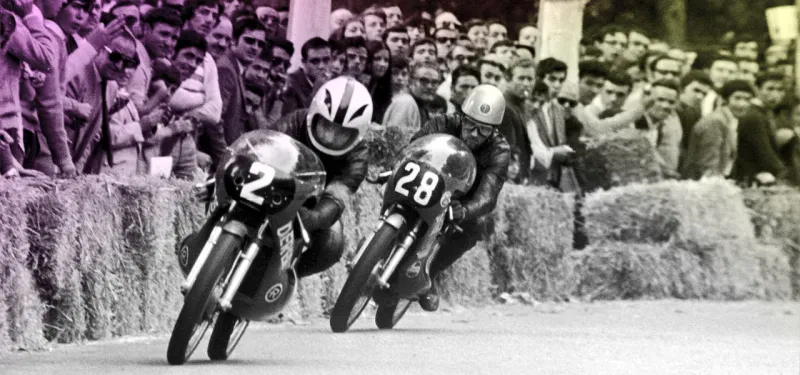
We wake up to the crowing of roosters and the chime of church bells, surrounded by pure nature.
After breakfast it’s time to get back on the bikes, and today I’d say we’re putting on the “yellow jersey”: we’re about to cross from Spain into France over the Pyrenees for the first time — just as it should be on a route called the “Transpirenaica.”
We leave Sort behind and ride between the Natural Parks of the High Pyrenees (watch out, bear country here!), Aigüestortes and Sant Joan de Toran, to enter France through Saint-Mamet. From there, we head towards two of the most legendary mountain passes of the Tour de France, that iconic race of our neighbours: the Port du Tourmalet and the Port d’Aubisque.
The Col du Tourmalet is one of the most famous climbs in Tour de France history. Sitting at 2,115 m in the French Pyrenees, it’s been included in the Tour over 85 times, making it by far the most featured climb of all time.
In 1910, the very first Pyrenean stage of the Tour passed through here, becoming legendary for the shout of cyclist Octave Lapize who yelled “Murderers!” at the organisers, furious at the brutal ascent on dirt roads. Pure history from one of the toughest races in the world.
On a motorbike, it’s spectacular — a twisty route with stunning views of alpine pastures and the Pic du Midi observatory, visible from the summit.
As for the Port d’Aubisque, it stands at 1,709 m in the Atlantic Pyrenees, linking Laruns with Argelès-Gazost. It’s famous for its scenic section between Aubisque and Soulor, a narrow road carved right into the rock called the Cirque du Litor, complete with sheer drops that leave quite an impression. These are the sorts of roads you never forget — riding with the rock face as your travelling companion truly makes you feel connected to the mountain.
This pass has featured in the Tour over 70 times and was almost synonymous with it in the 1950s.
And here I’ll raise my hand again to say: please enjoy the challenge and the scenery, but with respect. There are sections without guardrails where you often see livestock roaming. We won’t be doing bicycle speeds, but let’s not go much faster either, alright?
We’ll stop for lunch on French soil and get our first taste of Pyrenean cuisine on this side of the border.
We’ll arrive in Pau in the mid-afternoon as usual.
Did we stop here by chance? Are you serious? Let me give you a couple of reasons...
Culturally speaking, Pau sits on a natural balcony over the Gave de Pau valley, with spectacular views of the Pyrenean range, especially from its famous Boulevard des Pyrénées, a nearly 2 km panoramic promenade commissioned by Napoleon III, dotted with benches and viewpoints. It’s said to be “the most beautiful balcony in Europe.”
It’s also the birthplace of King Henry IV in 1553, the first Bourbon to reign in France and Spain. His château, the Château de Pau, can be visited (though we probably won’t have time, but take note in case you come back), and holds historic artefacts, plus a rather curious giant tortoise shell which, legend says, was his cradle. More historic legends — I love them.
Think that’s it? Wait, there’s more!
Pau has hosted the Grand Prix de Pau since 1933, one of the oldest street races in the world, run through the very streets of the city with tight corners, elevation changes and almost no run-off — very Monaco style. These days it’s for Formula 3, touring cars and classics, but once upon a time legends like Juan Manuel Fangio raced here, a man some call the greatest Formula 1 driver of all time.
He was five-time F1 World Champion (1951, 1954, 1955, 1956 and 1957), a record that stood for 46 years until Michael Schumacher (who else?) broke it in 2003. He did it driving for four different teams: Alfa Romeo, Maserati, Mercedes-Benz and Ferrari — absolutely unique in history.
Driving or walking along this street circuit, which is open to normal traffic when there’s no race, has a special flavour for us motorsport fans — that faint whiff of exhaust and burnt rubber we love so much.
The most dangerous thing we’ll do tonight is probably deciding what to have for dinner.
Get ready for dishes like foie gras and duck confit, because Pau is right in the heart of France’s southwest, famed for its foie gras. Here it’s eaten as terrine, seared fresh, or with figs and toasted bread. Confit de canard (duck leg slow-cooked in its own fat) is another classic, usually served with potatoes sautéed in duck fat, called pommes sarladaises.
We can’t forget the Pyrenean sheep cheeses (Ossau-Iraty), a PDO cheese with a mild flavour and buttery texture, or Pyrenean lamb (Agneau des Pyrénées), raised at altitude which gives the meat a delicate taste, typically oven-roasted with herbs or in a stew (navarin d’agneau). Delicious. All washed down with Jurançon wine and topped off with local desserts like tourte des Pyrénées, a tall fluffy cake often flavoured with rum or vanilla, or pastís gascon / croustade, a fine pastry filled with apple and Armagnac.
I told you choosing what to eat in Pau was going to be a high-risk activity!
We’ll dine and then head straight to bed — we’ll definitely be ready to crash.
Tonight, we’ll be lulled to sleep by the old echoes of roaring engines.
Good night!
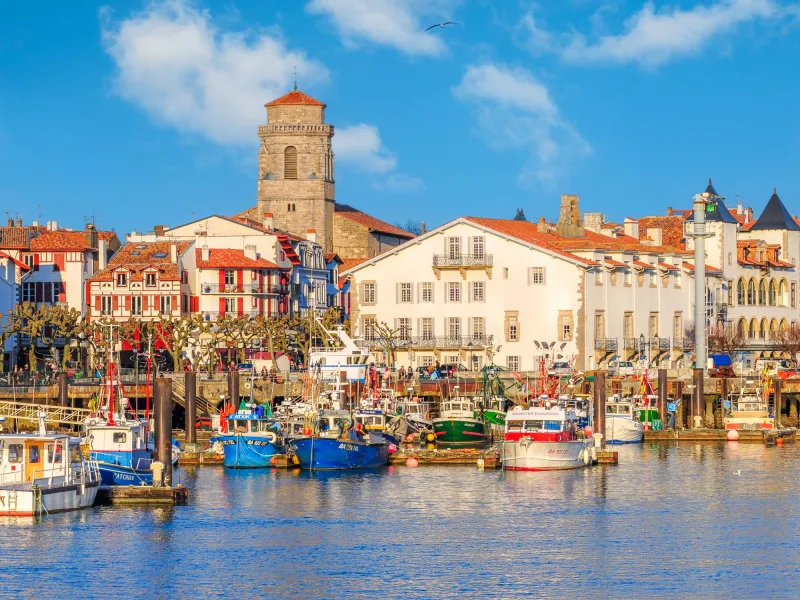
After a nice, relaxed breakfast — today’s stage isn’t particularly long, so there’s no rush.
I try not to hammer us with endless daily distances. In the end, this is about enjoying ourselves, not about tearing along until we’re knackered after just a couple of days… you know exactly what I mean.
So off we go, bellies full, heading for the furthest point of our trip, which will also mark the start of our way back: Saint-Jean-de-Luz. I’ll tell you more about that later.
But don’t be fooled — even if I haven’t packed the route with loads of miles, the ones we do ride we’ll enjoy to the max, that’s for sure!
Part of that “enjoyment” means playing with the border between France and Spain. We’ll cross via Arette La Pierre Saint-Martin back into Spain, then head straight to Roncesvalles, only to return once again to France, staying there until the end of today’s stage.
But let’s pause at the two “key” spots of this stage for me. The first is the Col de la Pierre Saint-Martin.
It’s a stunning mountain pass for bikers, linking Arette La Pierre Saint-Martin (on the French side) with Isaba and the Roncal Valley (Navarre, Spain). One of those Pyrenean passes that steals the heart of anyone who tackles it on two wheels.
From the French side, it’s a more gradual, smoother climb, with long sweeping bends through forests and alpine meadows. When you reach the ski station (1650 m), the landscape suddenly turns almost lunar: open meadows, white karst formations and endless views. It feels like the sheer vastness of nature could swallow you up in a second.
Just before crossing into Spain, under the cyclists’ monument, we’ll stop for the essential photo. If there’s no photo, you didn’t really do the pass!
Once in Spain, the descent to Isaba is much tighter and twistier, with linked bends perfect for enjoying some technical riding. Meanwhile, the landscape shifts to a lush green and deep forests, providing the perfect backdrop for that grin we’ll be hiding inside our helmets.
Quick safety note here: watch out, as this pass is pretty exposed. Even in summer you can hit fog or strong winds. We’ll be enjoying it — but with care.
After the descent, stopping in Isaba for a plate of migas or some roast lamb is almost mandatory. Loads of biker groups use it as a meeting point for routes through the Navarrese-Aragonese Pyrenees, and we’re not about to be any different, are we?
After lunch, we’re off to one of Spain’s most famous passes and the second “key” highlight of this stage: Roncesvalles.
Bit of history to set the scene. In 778, the famous Battle of Roncesvalles took place here, where Charlemagne’s troops were defeated by the Basques. According to legend, the hero Roland, Charlemagne’s nephew, died here after blowing his oliphant to call for help. This gave rise to the legendary Song of Roland, one of the most important medieval epic poems in Europe.
And don’t worry, I had to look it up too — an oliphant is a big horn carved from ivory, used in the Middle Ages to signal during battles or hunts. There, saved you the trouble!
As for bikes, it’s a legendary spot for motorcyclists — not so much for its height (1057 m) but for its history and its route. It links Roncesvalles with Saint-Jean-Pied-de-Port along the N-135 and D933, with gentle bends and lush green views that make you feel like you’re riding through a natural beech tunnel. It’s also the natural crossing between the Atlantic side of the Pyrenees and the start of the Camino de Santiago, so riding here feels almost like a ritual. If you fancy an epic route that takes in part of the Camino, check out our Desafío España: the route of all routes. You’ll love it.
We head back into France to reach the sea once more and arrive in Saint-Jean-de-Luz. And as I mentioned earlier, choosing to stay in this little fishing town instead of Hondarribia (like many other tours do) is purely practical. For almost half the price of a hotel in Hondarribia, you get a room just as comfy, right by the sea, plus dinner. So if we decide we must see Hondarribia, we’ll do it — but I refuse to let them rip me off for a mere 20 km difference. Put like that, I’m sure you’ll agree with me.
So we’ve arrived in Saint-Jean-de-Luz, checked into the hotel… what now? Exactly — I see you’ve been paying attention. Time to stretch our legs and soak up the stories of this coastal town, which in the 17th and 18th centuries was famous (and feared) as a privateer port. Local shipowners funded vessels with letters of marque, authorising them to attack and plunder enemy ships, mainly English and Dutch.
It’s estimated that over 600 privateers set sail from here in those centuries, hugely boosting the city’s wealth. Many of the elegant houses in the historic centre (like those on Rue de la République or the Maison de l’Infante) were built with the “money the privateers brought from the sea”. Poetic way of describing plundering ships, isn’t it?
The English called Saint-Jean-de-Luz “the viper’s nest” because of how many ships set out from here to attack theirs in the Bay of Biscay.
In fact, privateering was completely legal under the French Crown — a form of economic warfare that enriched local merchants and weakened the enemy without major state expense. As always, the house wins, you know how it is.
On the table, we’ll find a Basque-French feast blending traditional Basque flavours with French finesse.
The port guarantees ultra-fresh fish: turbot, sea bass, baby squid, bonito… plus the ttoro, a typical fishermen’s stew from this Basque coast made with assorted fish, shellfish, tomato and peppers — very much like a Basque bouillabaisse. And for dessert, the gold medal goes to the gâteau basque, filled with custard or black cherry jam. It’s the signature dessert.
Set all this in one of the seafront restaurants with the lighthouse shining at night, and you’ve got the perfect backdrop for one of the most unforgettable evenings of this guided motorcycle adventure we’ve embarked on.
Off to bed with the echo of sea battles in our heads… and tomorrow, there’s more.
Sleep tight, shipmate!
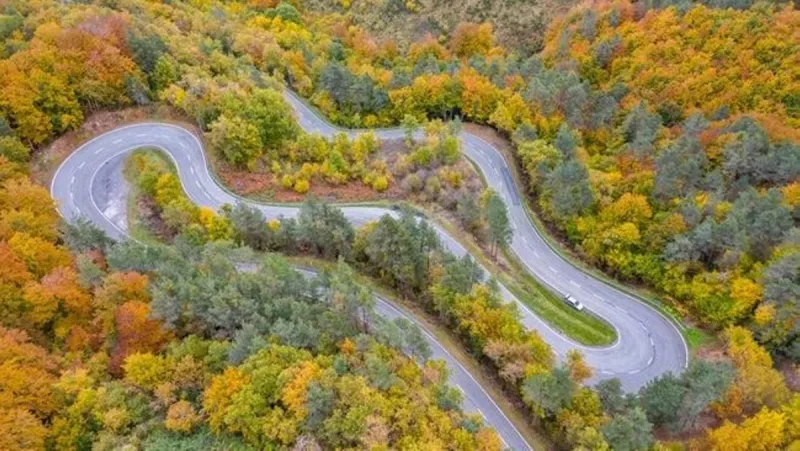
Good morning, everyone up!
Today’s route takes us entirely along the French side of the Pyrenees, tracing pretty much the same line as the border with Spain, but without actually crossing it.
We start out from Saint-Jean-de-Luz, maybe popping into Hondarribia if we fancy it, before heading east to leave the Cantabrian Sea behind and dive into a series of mountain passes and lush green landscapes that will truly satisfy our hunger for riding – and for doing it in stunning places.
Highlights today include passes – well, in France they’re called “cols” – like the Col de Sourzay, which sits on the border between Navarra and Aquitaine at around 1,020 to 1,130 metres.
We’ll ride past the quirky houses known as “Les Chalets d’Irati”, located in one of Europe’s largest beech and fir forests: the Irati Forest. We won’t be staying here tonight, but I’m taking note for future tours, so keep an eye out for what I’ll be posting!
The Irati Forest is the second largest and best-preserved beech-fir forest in Europe, only behind the Black Forest in Germany – another one of Europe’s most famous biker havens. Shall we plan a tour to enjoy it? Alright, I’ll hold you to that. A promise is a promise: I’ll create the “Black Forest with Toro Biker” tour and include Les Chalets d’Irati and all the promised stops. Sorted!
The Irati forest stretches over roughly 17,000 hectares, split between northern Navarra (Spain) and the French Basque regions of Soule and Lower Navarre. Its average altitude is between 800 and 1,200 m, with peaks like Orhi reaching around 2,017 m – the first 2,000 m+ summit since the Atlantic we’ve just left behind. So we’re going pretty high today. No matter the time of year, it’ll definitely be fresh.
This forest is mainly made up of beeches and firs, sprinkled with holly, yew and birch trees, with an undergrowth rich in mosses, lichens and ferns that give it a real fairy-tale feel. Ever watched or read The Lord of the Rings? Well, this could easily be Frodo’s homeland.
More than 120 species of birds live here, along with mammals like deer, roe deer, wild boar, foxes, martens and the elusive wildcat. In autumn, the deer’s rutting calls turn the forest into a unique soundscape. And mushrooms here are almost a religion: from field mushrooms to boletus and Caesar’s mushrooms.
Many writers call Irati a “sound forest” because silence doesn’t exist there: you’re constantly hearing leaves falling, twigs snapping, the call of jays, woodpeckers tapping away, the distant hum of the wind or even the whisper of water trickling through moss. That’s probably why locals say “Irati ez da sekula isiltzen” (“Irati never falls silent”).
We’ll grab something to eat along the way as usual, and of course we’ll stop again to snap photos that’ll earn a prime spot in our collection.
The cuisine around the Irati Forest is simple, authentic and, of course, mountain-inspired: lamb, migas, mushrooms, trout, sheep’s cheese and pacharán – all perfect to accompany a biker route through the most magical beech forest in Europe.
After lunch, still buzzing from the winding roads, we’ll arrive enchanted at today’s destination: Lourdes.
I grew up hearing the old saying “for miracles, go to Lourdes,” and regardless of your beliefs, it’s a place with enough history and charm to warrant a stopover.
Before the 19th century, Lourdes was a small town clustered around its castle (the Château fort de Lourdes), with a history tied to medieval conflicts and border shifts. During the Hundred Years’ War it passed from French to English hands and then back again.
The castle, with its 11th and 12th century walls, still dominates this town that was once a strategic military point… until 1858, when a 14-year-old miller’s daughter named Bernadette Soubirous claimed to have seen 18 apparitions of the Virgin Mary in a grotto by the River Gave (the Grotto of Massabielle). Not one or two, but 18 – just in case a couple weren’t enough, you know…
According to Bernadette, the “lady dressed in white, with a blue sash and roses on her feet,” spoke to her in the local dialect and asked for a chapel to be built there. So they didn’t really have much choice, did they? In one of the apparitions, Bernadette also discovered a spring of water that’s still considered miraculous today.
Civil authorities were initially sceptical and interrogated her harshly, but spontaneous pilgrimages kept growing. In 1862 the Church recognised the apparitions, and a small shrine was built. Lourdes was transformed overnight. A miracle indeed!
And here’s a real fact: today Lourdes receives between 3 and 6 million pilgrims each year, making it the second most visited Catholic pilgrimage site in the world after Rome.
See? We just had to stop here. On top of that, Lourdes is a perfect launchpad for riding the Pyrenean cols: Tourmalet, Aubisque, Soulor (which we’ve already tackled) and heading on to Andorra, which is our goal.
The truth is, this mix of devotion, souvenir shops, candles everywhere, pilgrims walking barefoot or praying the rosary, plus tourists who come simply to enjoy the mountains, makes this little town quite unique. And if we’re lucky enough to witness the evening torchlight procession at the sanctuary, with thousands of candles and devotees singing Ave Maria in multiple languages, you’ll see it’s a truly moving, almost film-like spectacle.
After unloading our bags at the hotel and freshening up, we’ll stroll around to soak up the local vibe before heading to our selected restaurant, where we’ll indulge in the region’s delights.
Think platters of local charcuterie (saucisson sec, Bayonne ham, country pâté) with some fromage des Pyrénées (sheep’s cheese similar to Ossau-Iraty), Garbure soup, confit de canard with crispy skin and juicy meat, often served with pommes sarladaises (potatoes sautéed with garlic and parsley). Don’t miss the Truite des Gaves, trout from the Gave river running through Lourdes, served almondine or grilled with herbs. And of course, Magret de canard, a thick duck breast grilled rare with berry or green pepper sauce.
For dessert there’s Gâteau à la broche, the famous spit-roast cake typical of the French Pyrenees, Pastis, a kind of slightly flaky cake flavoured with anise or rum, and to help digestion, a sorbet de cassis or framboise, homemade blackcurrant or raspberry sorbet.
After this feast, we’ll head to bed – tonight with heavenly hymns as our lullaby.
Good night, see you tomorrow!
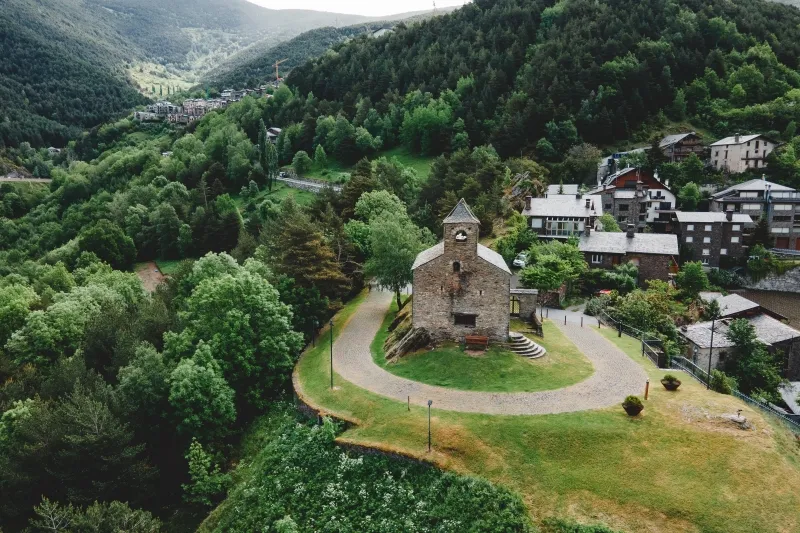
Good morning — let’s get going with energy, because today comes the part of this guided motorcycle tour that I personally like the most.
After breakfast, we hop on the bikes and head towards Andorra. Of course, over the roughly 350 km that make up today’s route, we’ll be taking the roads with the most bends, enjoying the most stunning landscapes possible — and eating incredibly well along the way. In other words: a 100% Toro Biker day!
It’s hard to pick today’s scenic highlight, because lush landscapes and wide meadows at the foot of towering mountains will be our backdrop all day. But as usual, I want to give you a few facts about the journey. Today, I’ll tell you we’ll be riding through bear country… yes, you read that right, bears.
The Parc Naturel Régional des Pyrénées Ariégeoises was created in 2009 to protect an exceptional area covering nearly 2,500 km² in Ariège (Occitania). It’s home to an incredible biodiversity, with over 2,000 plant species, brown bears (this is one of their last refuges in the Pyrenees), chamois, marmots, and even wolves, which data suggests are starting to return. So yes, this time it really is worth taking each bend carefully — you wouldn’t want to meet a bear keen on a motorbike ride.
We’ll pass medieval and Cathar villages that look like they’ve stepped out of a storybook — names like Saint-Lizier (with its Romanesque cathedral) or Foix, with its castle, will stick in our memories.
This route is a real paradise for bikers: spectacular mountain passes, generally good tarmac, and very little traffic. What more could you ask for? Oh yes, eating superbly well, of course!
Among the traditional local dishes we’ll be able to try is Garbure, a hearty stew with cabbage, potatoes, beans, duck confit or ham, typical of the entire Pyrenean region. Then there’s Cassoulet, prepared here with white beans, Toulouse sausages, duck confit and pork rib — an absolute treat. Or the Civet de sanglier or de cerf, a wild boar or venison stew slow-cooked with red wine, onions and mountain herbs, a real autumn classic.
Of course, we couldn’t miss the Truite des Pyrénées, fresh river trout often served with garlic or almonds. Honestly, you can’t come home without trying this trout, wherever we stop. Personally, I think it’s delicious.
In the cheese and charcuterie section, you’ll find local gems like Bethmale, the most iconic cheese of Ariège — a semi-cured cow’s cheese (sometimes mixed with goat or sheep milk), soft, with hazelnut notes, born in the Bethmale valley right in the heart of the park. Whoever decided on that hint of hazelnut absolutely nailed it. Then there’s Moulis, stronger than Bethmale, made in small artisan dairies. Here, cheese tastes like cheese, not plastic — you know exactly what I mean.
A special mention goes to the local charcuterie: mountain saucisson, hams cured at altitude, and spiced sausages. Ordering a platter of these specialities is like grabbing a slice of heaven and popping it in your mouth.
Finishing off with something sweet is the perfect ending, and here you can choose from Croustade, a puff pastry filled with apple or plum, sometimes with a splash of Armagnac or rum; try the miel de montagne, aromatic, floral, with notes of heather, made by small local producers; or a pastis (aniseed cake) and candied fruits.
If all this, in moderation (remember, we still have to ride afterwards), is accompanied by wines from the Pays d’Oc or artisan wines from small local wineries, finished off with an Armagnac digestif, we’ll have truly done it in style.
Another option for lunch today is to stop at one of the many roadside auberges, where the menu of the day often includes garbure or civet. It’s not unusual for the owner to come over and chat about the pass we’ve just ridden. Here, bikers are respected and they make sure your stop is as pleasant as possible. No doubt about it — the hospitality of these places is a real strength.
After this fantastic meal, we get back on the road to enter Andorra via its eastern side at Pas de la Casa, to reach our destination for today: Anyós.
I think it was in 1993 when I first visited this resort on the hillside in Anyós, and ever since, for me, Andorra basically means staying here.
Even back then it boasted its amazing “infinity” pool with aluminium floor and walls, installed so the sun could warm the water a bit, since it cools down a lot overnight. Truth be told, it still stays pretty cold, no matter how much sun it gets.
Alongside a chill-out terrace and a couple of restaurants, it has a full saltwater spa, tennis courts and, most recently, paddle courts — jumping on the paddle craze, which I confess I’m a fan of. To sum it up quickly: if you’ve ever been to Caldea in Andorra or know what it’s like, this resort offers the same, just without having to queue for two hours for a shower. Long live privacy.
Dining at one of its restaurants is more than recommendable, but we’ll save that for tomorrow. Tonight, we’re going to have dinner at what is without doubt my favourite borda in all of Andorra and the surrounding ski resorts. As if that wasn’t enough, they moved it a few years ago right to the road leading to the resort, so we can just walk down and back up.
Rice dishes, game, of course caracoles a la llauna, grilled meats — everything this borda serves, carefully overseen by its owners, is simply delicious. They pay absolute attention to both the quality of their products and how they’re prepared.
Every time I’ve been (and I think I’ve now eaten my way through the whole menu), I’ve had the feeling the owners do everything with love — yes, love. The warm, attentive service, the peaceful atmosphere, the way the dishes are crafted in the kitchen — it all has that “taste of love” that, in my view, sets this place apart from just any old restaurant. Look, their son is about the same age as mine, and on one trip I bought my son his first toy drone. When we went for lunch, it turned out their son also had one, so you can imagine how much fun they had flying them around the car park… total joy, until one drone got lost in the undergrowth and was never found. They’re probably still looking for it — the local vegetation is seriously thick. Anyway, just another of those little biker stories we end up telling over the table, you know how it is…
After dinner, we’ll walk back up to the hotel. Tonight, we can stay up chatting in the chill-out area (as long as it’s not too cold), because tomorrow is a rest day on the tour.
As long as we like — and then, goodnight!
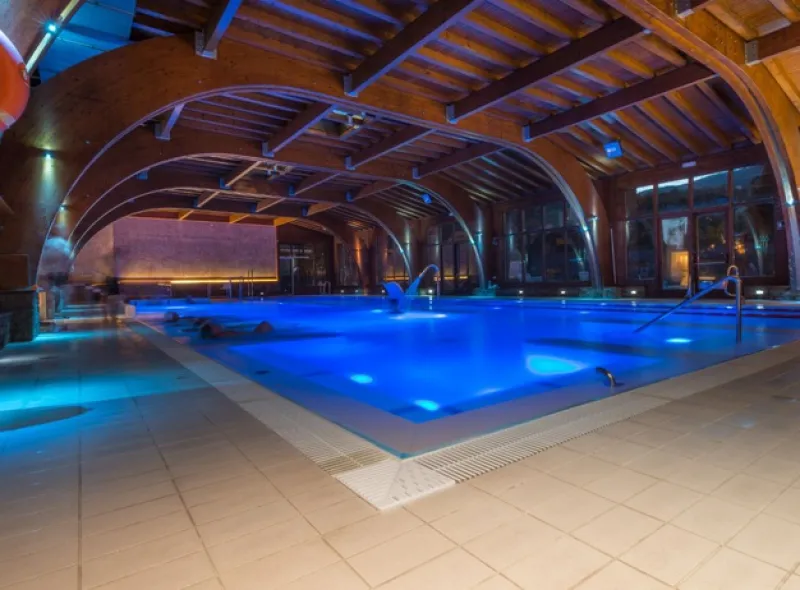
Good morning, today is a rest day.
That’s right — since the resort where we’re staying gives us the chance to chill out all day, we’re taking a proper day off.
But if you don’t fancy ending up looking like a prune after spending hours soaking in the SPA, here are a couple of suggestions for today — basically what I’m planning to do myself. And if you like the plan, I’d be glad to have you join me.
There’s no alarm clock today, no rush at all, although to be honest I doubt I’ll stay in bed past 8:30 or 9:00. We’ll have a relaxed breakfast at the hotel, and around 10:00 we’ll ride down to Andorra to stroll along the main street, do a bit of window shopping and maybe buy a few things.
Speaking of shopping in Andorra, let me tell you that years ago (quite a few now), when we used to come up from Valencia for the weekend — something loads of Valencians did back then — it was almost a sin to go back home without a ball of cheese, some milk, a bottle of whiskey, rum or vodka, and of course perfume, trainers or Levi’s 501s, whether you needed them or just to bring back for friends who’d asked. The savings were absolutely worth it in the “Land of the Pyrenees”.
Obviously things have changed a lot, and while it’s no longer worth the trip just to buy milk and sugar, Andorra still has much lower taxes on products than the rest of Europe. So if you’re coming anyway — for skiing, a holiday, or just to relax — it’s still a bargain. Whether it’s worth it compared to prices in your own country is something only you can check. Also, don’t forget you’re travelling by motorbike. Sure, that new TV might be cheap, but I doubt it’ll fit in your top case. One more tip: if you do buy something, tell the shop assistant what country you’re from. You might get the VAT knocked off, saving even more. And by the way, haggling has become quite trendy here (it didn’t use to be). Always ask for a discount, and once you’ve agreed on a final price, THEN ask about the foreign-tax thing — you might end up paying even less. Keep the receipt safe; they’ll usually ask for it at the airport when you head home.
Two more notes:
If you’re here on your own bike, I’d seriously recommend wearing out your tyres and changing them here. Loads of places sell and fit them on the spot — fast and cheap. Same goes for any bike accessory, riding gear or gadget that catches your eye. That jacket you love, the helmet that keeps winking at you, gloves, trousers, boots... My tip: check prices in your country before the trip, then compare in Andorra and decide. Also, be clear on what you want to compare — if you go “just to see”, you’ll end up dizzy with so much choice. Happens to me every time.
For the smokers: in the supermarkets where they sell tobacco (usually stacked in towers by the entrance), you’ll often see two prices for big brands. The more expensive is the original imported brand — just check if it’s still cheaper than back home. The cheaper option is what they call “Andorran tobacco”: still imported, but mixed with lower-grade varieties so they can sell what looks like the same product at a lower price. Up to you, now you’re informed.
Another classic Andorran buy is perfume, cologne and so on — again because there’s no VAT like in Spain or generally across Europe, so it’s always worth it.
After maxing out the credit card a bit, the plan is to head back around midday, have a refreshing swim (don’t forget your swimming gear), grab some lunch and maybe a nap — what we call a “siesta”, which honestly should be declared a World Heritage activity — before heading down again to enjoy the different options of our private SPA all afternoon.
Let’s get pampered by the pool jets, bubble beds, more jets hitting different parts of the body (the neck ones are fantastic for us bikers), various jacuzzis, sauna, hot and cold showers... a whole complex dedicated to the “dolce far niente” as they say in Italy. Oh, and if you have a swim cap, pack it with your trunks — the ones they sell at SPA reception are either ugly or overpriced.
For the real connoisseurs, there’s also a full menu of massages and beauty treatments. So there’s truly something for everyone.
Plus, there are padel, tennis and squash courts if you fancy something a bit more active, and even a couple of ping-pong tables. I challenge you to a ping-pong match — shall we have a mini tournament and a good laugh?
Nicely chilled and with that relaxed “flow” you get after a solid SPA session, we’ll have dinner at the resort’s restaurant — either at the Sport or the more formal one, whatever we feel like.
Then off to bed, still basking in that blissful state. Tonight we’ll drift off, cradled by the afterglow of the spa, straight into dreamland.
Good night!
P.S.: Just a reminder — everything I’ve described for today is simply a suggestion. Today’s completely free and everyone’s free to do whatever they fancy. Of course, if you’d like me to point out a nearby motorbike route or recommend a particular shop, just let me know and I’ll be happy to help.
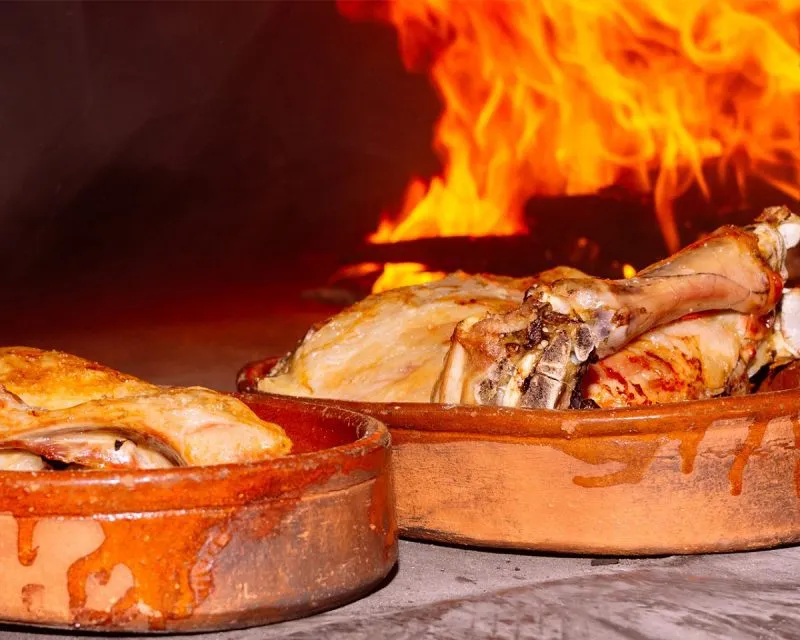
Good morning!
Up and at it with full energy again because today we’re back on the road — and since we’re well-rested, we’re stretching the route a bit, getting close to 400 km.
Leaving Andorra behind, we’ll ride along quiet secondary roads that skirt stunning lakes, wind through jaw-dropping natural gorges, and gradually turn into low forests that finally open out into vast, endless plains.
If I had to give today’s ride a label, I’d call it a “pure pleasure” route. Sure, there’ll be some traffic — can’t be helped, especially until we’ve put a fair few miles between us and Andorra — but then we hit that sweet section where riding in a group turns into a proper dance of bikes and bends. You dancing?
Lunch will be at one of the many roadside restaurants we’ll find in every little village we pass. Yes, I’ve got a favourite, but more than once I’ve left it to chance, depending on the time, and wherever I’ve stopped, it’s been spot on.
They all do a set menu with a couple of options for starters and mains, and the local Catalan cuisine is so good that we can’t go wrong, no matter where we end up.
Cold cuts, salads, meat and fish (maybe that last one’s slightly riskier at these places), plus my beloved snails, which are on every menu, along with house specials if you feel like going à la carte. So today’s all about enjoying it: when it feels right and we’re ready, I’ll book us in somewhere on the fly. Sorted.
After lunch, we keep heading south to ride through the Sierras de Cardó-El Boix. What, did you think there’d be no curves today? Ha! This rugged mountain range lies in the far south of Tarragona province. It’s a wild area, almost untamed, with deep ravines and lush Mediterranean vegetation. Keep an eye out for the hermitages dotted around the mountains, many carved into the rock or perched dramatically on cliffs — absolutely spectacular.
The landscape gives us narrow, twisting roads with constant bends and hardly any traffic, perfect for enjoying the ride in stunning natural surroundings. From the peaks, you can see all the way to the Ebro Delta and, on clear days, even the Mediterranean. Yes, we’ll stop for as many photos as you want — no rush!
Tonight’s hotel awaits us in Morella, which is more than just a village — it’s a trip back in time. It’s a historic walled town in northern Castellón province. Its skyline, with an impressive medieval centre encircled by over 2 km of walls and crowned by a castle standing 1,070 m above sea level, is absolutely unmistakable.
Beyond its architectural treasures — cobbled streets, gothic churches, fortified gates — Morella is set in mountainous countryside with oak forests and rugged landscapes that often turn snowy in winter. It’s famous for its black truffles, lamb (especially the local “cordero al horno morellano”) and artisan cheeses.
So after we unload at the hotel and freshen up, we’ll have our usual wander and then dinner at our selected restaurant, where today’s star will be the “Cordero al horno Morellano”, a traditional dish from the Els Ports region. It’s made with tender suckling lamb, raised on local pastures, giving it a beautifully delicate flavour.
The secret is in its slow wood-fired roasting, often with potatoes, garlic, rosemary, thyme and a good glug of olive oil, so the meat stays juicy inside with a crispy, golden crust. It’s a typical Sunday or celebration dish, usually served with fresh salads and local red wine. Any doubts about what we’ll order? Maybe just which wine to go for — that’s about it.
Don’t worry if lamb’s not your thing: you can pick from loads of other local delights, like the Fideuà morellana, a mountain-style version of fideuà made here with meat (usually chicken or rabbit) and local mushrooms instead of seafood, or try one of the many wild mushroom stews, often starring the famous Morella black truffle. In winter, menus overflow with simple but sublime dishes like truffled eggs, mushroom carpaccios or scrambled eggs.
Just like on the road, and at the dinner table too — no one gets left behind here. We’re a bit like the Navy Seals that way! Haha.
We’ll dine and then drift off to sleep, lulled once again by the distant whisper of the Mediterranean.
Good night!
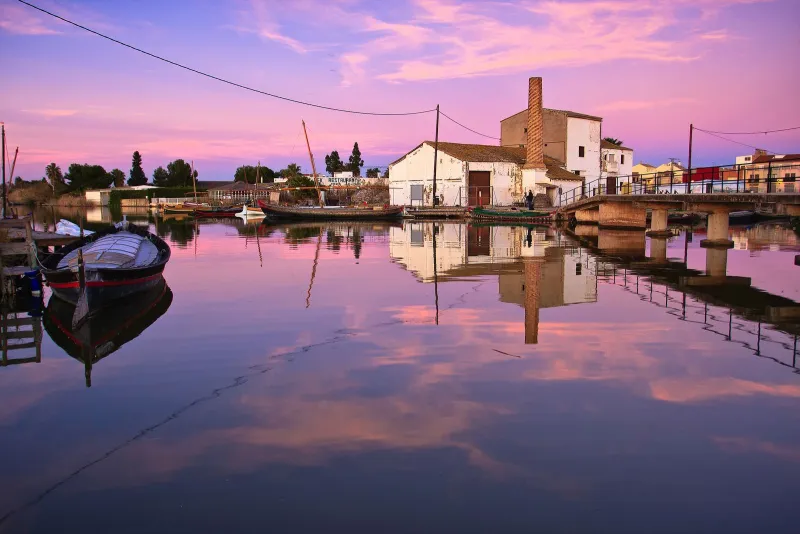
Good morning!
After breakfast and getting the bikes ready, we set off on this last stretch, which won’t be very long, but will definitely be a lot of fun.
We return to Valencian lands to enjoy a route full of curves and purely Mediterranean landscapes, among which I highlight today the passage through the Calderona Mountain Natural Park, a mountain massif located between the provinces of Valencia and Castellón that acts as the gateway to the Iberian System and is considered the “little sister” of the Espadán Mountains (we enjoyed that one on other routes, take a look at the website if you want), although with its own character.
Its highest point is Garbí, known by every local biker who prides themselves on calling it that, thanks to its viewpoint with spectacular views of the Gulf of Valencia, the Mediterranean Sea, and on clear days, even the Columbretes Islands. If we have time, we will make a slight detour to visit it—I believe we will have enough time.
But before reaching Garbí, as I said, we will go through the Calderona Mountains, a small paradise of curves that fill up on weekends with motorcyclists due to their asphalt, open landscapes, and winding but safe stretches. Its easy access from Valencia makes it a tempting spot that is hard to resist.
Watch out for groups of cyclists, who are also very common on these roads. Like it or not, we share many routes with them, and the speed difference makes encounters between motorcyclists and cyclists potentially dangerous. Respect and care on both sides—that’s all that’s needed.
Remember how San Juan de Luz was a corsair town? Well, the Calderona Mountains were a refuge for bandits in the 18th and 19th centuries, who took advantage of its rugged terrain to hide.
During these centuries, the Calderona was a mandatory passage between the mountainous interior of Teruel and the fertile Valencian orchard. This meant coaches, muleteers, and merchants transporting goods, often without escort and therefore easy prey for bandit gangs.
It is said that in the 19th century, some of these groups were so well organized that they had informants in nearby towns like Náquera, Olocau, and Serra, who warned them about passing carriages carrying money or jewellery. After the attack, they would retreat deep into the mountains, which they knew intimately, making capture almost impossible.
There are legends of caves and secret hideouts where they stored loot or hid for days. Popular stories talk about bandits, famous for their cunning, who managed to outsmart the Guardia Civil of the time more than once by disappearing into the trails of the Calderona. You see, it’s all about being clever!
I’ve told you all this so you know that the roads we’re enjoying today on our motorcycles, going through these mountains, are none other than the old routes these bandits used for their exploits. Don’t you think knowing this kind of history changes your perception of the places you pass through? I believe it does.
Our destination for lunch is El Palmar, and pay attention to this village’s location and history because it has its own peculiarities.
El Palmar is a district of the municipality of Valencia located right inside the Albufera Natural Park, about 20 km from the city centre. It’s a small village surrounded by rice fields and canals that flow into the great lake, with barely 800 registered inhabitants, although in summer and on weekends the number grows a lot due to gastronomic tourism. Rice dishes in general, and paella in particular, attract thousands of “fans” every weekend—I can vouch for that.
Originally, it was a cluster of fishermen’s huts and rice farmers’ shacks. Today it still retains an authentic flavour, with narrow streets and low houses often decorated with reeds, nets, and fishing tools. A perfect showcase for visitors.
Life in El Palmar has always revolved around fishing and rice cultivation, and for centuries, men dedicated themselves to fishing by boat on the Albufera, catching eels, sea bass, mullet, or samarucs, while women usually worked at home, in the rice fields, or in complementary tasks like mending nets.
But there was a very curious tradition—I already told you this village had its “quirks”: Women were forbidden from going out to fish, and note that this was not by written law but by deeply rooted beliefs and superstitions. Fishermen’s stuff, you know... It was said that the presence of women on fishing boats brought bad luck, “scared the fish away,” or “stirred the waters.” So although they helped a lot on land, they rarely stepped on the boats (called albuferencs) destined for fishing. What would the fishermen do on the boats all day to not want women on board? Mystery. As far as I know, no fisherman from El Palmar has spoken on the matter. :-P
I know this from what we call “old wives’ tales,” but eventually, with modernisation, social changes, and much struggle from women who wanted to fish, some women began to fully participate in the activity. Don’t miss this: women started going out fishing occasionally in the 60s and 70s, but normalisation came mainly from the 80s and 90s onwards. Maybe these are “old wives’ tales,” but not that old, right!?
Well, after this curiosity or this ode to the triumph of gender equality, I’ll keep telling you that another driving force of the village is undoubtedly rice. The flooded fields surrounding the village create a changing landscape with the passing seasons. The rice cycle is a spectacle: from planting in May-June, the growth of a green sea in summer, to the harvest in September-October, when everything turns golden. Here I have a surprise for you, but I won’t tell you because otherwise, it wouldn’t be a surprise, obviously... ;-)
This rice is the base of the authentic Valencian paella, the "arroz del Señoret" (*), and a thousand creamy and soupy rice dishes that can be enjoyed in the village’s numerous restaurants. The healthy competition among restaurants to offer spectacular rice dishes on their menus is the best thing that can happen to lovers of this culinary delight. Some seem out of this world, truly.
(*) I invite you to look up the “legend” that connects the name of this arroz del Señoret with the illustrious writer Vicente Blasco Ibáñez—I would share it, but today’s text would get too long.
It’s impossible to talk about El Palmar without giving due honour to Vicente Blasco Ibáñez, whose work Cañas y Barro, written in 1902, takes place precisely here, in El Palmar.
The book (100% recommended) realistically portrays the hard life, passions, misery, and pride of the fishermen and farmers of the lake. Characters like Tío Paloma, Tonet, Neleta, or Sangonereta are already part of Valencian folklore. So much so that there’s a Valencian nickname applied to those who eat too much, called “Sangoneras,” after a character in the book who dies in a boat in the middle of the Albufera from a food binge.
El Palmar lies at the heart of a unique ecosystem: the Albufera. It is a passage for thousands of migratory birds and a paradise for birdwatchers. In the past, hunting was allowed from inside a barrel, but all that ended many years ago.
It is common to see traditional boats with lateen sails navigating the lake, a spectacle almost frozen in time for the delight of the most diverse tourists.
Although until a few decades ago many families still lived in huts, today only a few authentic ones remain standing and have been declared cultural heritage sites.
To finish this little monograph about El Palmar, I leave you an old local saying: “In El Palmar, there are three things: mosquitoes, fishermen, and lies.” It refers to the humorous and exaggerated nature of the local fishermen’s tales. Remind me to tell you a fishermen’s joke from El Palmar—you’re going to laugh.
Well, here we will order a Valencian paella and an arroz del señoret for lunch, so those who want meat, have meat, and those who want fish, fish.
Of course, we can’t miss a good salad with tomatoes from El Perelló (another simple yet spectacular delicacy—some people I gave them to over 10 years ago still ask me about them, no joke) and a good sangria to wash it all down. The rest will be laughter and biker stories shared with the joy of having completed a route that will remain in our memory for many years.
After lunch, we will return skirting the Albufera (and if we have time, we will have sailed it by boat) and take some photos of the most typical scene of Valencia from the dock on the El Saler road.
At the hotel, we can freshen up, and we will bring you the suitcases we stored on the first day so you can calmly pack again at night or early the next morning for the return trip.
We could have dinner near the hotel and have a more relaxed evening, but... who wants to rest after the excitement of an experience like this? Not me. So... what if we end the last night with a bang? Yes, right? Okay, you’ve convinced me! Haha
We are going to dinner at a restaurant with a live Flamenco show. How does that sound?
Isn’t finishing a guided route like this with the sound of clapping, singing, and flamenco dancing the perfect way to end it? Well then, no more words—consider it done.
The menu includes an Andalusian Rebujito aperitif, selection of breads with tomato sauce and olive tapenade cream, Iberian ham and cheese board, green leaf salad with Valencian orange, goat cheese, fried onion, cherry tomatoes, citrus and Pedro Ximénez vinaigrette, cod loin confit with vegetable stew, beef cheek in red wine over creamy potatoes, apple tatin with vanilla ice cream and pecan nuts, and a glass of cava to finish. I don’t know if we will manage it all, but this menu is worth it for what it contains and because it gives you access to a preferential table next to the stage. If someone breaks out into bulerías, they will be right next to it.
And if that wasn’t enough, at the end, the bravest among us will go for a drink at the bars around the restaurant, located in one of the most interesting nightlife areas of the city. We’re in Valencia, and here the party never stops!
Whenever we finish, straight to the hotel to rest, and tomorrow, more.
Good night, olé!
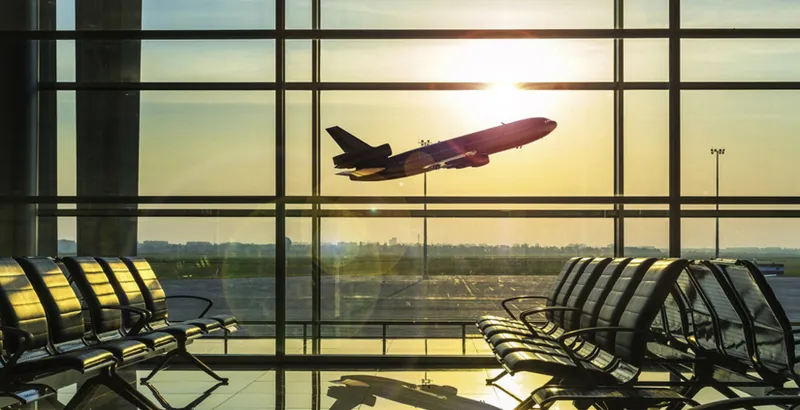
Good morning!
Get up, come on, get up, don’t be lazy—today we face the part that always feels the hardest in these trips: the farewell.
We wake up at the hotel, each with their own hangover if they have one, and after packing for the return trip and having breakfast, those who rented motorcycles will go to return them. If that’s not your case, you can relax with us a bit longer or head back home with our blessings, a big hug, and a biker farewell that always ends the same way: ride safe.
After dropping off the bikes, we will take each of you to wherever you need to leave from to head home—be it the airport, the port, the train station, or the rental car pick-up point. We’ll make sure you have plenty of time so you don’t miss your transport.
Well, we’ve come to the end of the trip—or as I prefer to call it, we’ve reached the beginning of the memories, the smiles when you picture that landscape, the sparkling eyes when echoes of stories told around the table come to mind, and a friendship that only those of us who love motorcycles can truly understand.
You can do a thousand things alongside thousands of other people and still have them be perfect strangers to you, but you will never leave a route like this without creating bonds of friendship that will last your whole life. Don’t doubt that this is exactly one of the main reasons why Toro Biker’s guided motorcycle tours are limited to a maximum of 10 bikes.
Until the next route, friends.
Ride safe always!













